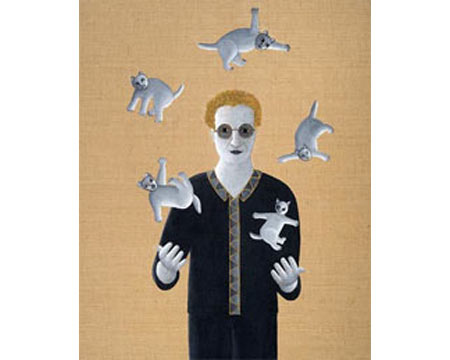Orlando Leibovitz
at Linda Durham Contemporary Art, Santa Fe, New Mexico
Recommendation by Kathryn M. Davis
 Orlando Leibovitz, 'Schrödinger and the Quantum Cats,' 2009, acrylic on jute, 54 x 44'.
Orlando Leibovitz, 'Schrödinger and the Quantum Cats,' 2009, acrylic on jute, 54 x 44'.
If you think that Schrödinger’s cats are some kind of feline rescue outfit, this exhibition may not be for you. If, however, you love contemplating such topics as the intersection of art and science, then "Painted Physics" hits the mark. As Orlando Leibovitz posits the pairing, “An appreciation of truth and beauty is another link between art and physics.”
The exhibition consists of nine acrylic-on-jute paintings in their own distinct gallery—a nice touch for work that requires a separate course of consciousness and consideration. Leibovitz’s work speaks through the vocabulary of folk art: super-flatness, simplified yet expressive figures, a color palette that seems limited to what’s at hand, and fanciful subject matter. Such major physicists as Murray Gell-Mann, Richard Feynman and, of course, Albert Einstein, are depicted as the prodigal youngsters they probably were. The artist’s whimsy results in all of the portraits appearing to have been posed at the circus. Gell-Mann rides a gloriously tawny jaguar; Feynman is nearly balletic in white in front of his blackboard of equations; while Einstein, with gold hair, eyebrows, and mustache, sits astride rhythmic electromagnetic waves. The universe, with all of its truth and beauty, belongs to them, one quark at a time.
If you think that Schrödinger’s cats are some kind of feline rescue outfit, this exhibition may not be for you. If, however, you love contemplating such topics as the intersection of art and science, then "Painted Physics" hits the mark. As Orlando Leibovitz posits the pairing, “An appreciation of truth and beauty is another link between art and physics.”
The exhibition consists of nine acrylic-on-jute paintings in their own distinct gallery—a nice touch for work that requires a separate course of consciousness and consideration. Leibovitz’s work speaks through the vocabulary of folk art: super-flatness, simplified yet expressive figures, a color palette that seems limited to what’s at hand, and fanciful subject matter. Such major physicists as Murray Gell-Mann, Richard Feynman and, of course, Albert Einstein, are depicted as the prodigal youngsters they probably were. The artist’s whimsy results in all of the portraits appearing to have been posed at the circus. Gell-Mann rides a gloriously tawny jaguar; Feynman is nearly balletic in white in front of his blackboard of equations; while Einstein, with gold hair, eyebrows, and mustache, sits astride rhythmic electromagnetic waves. The universe, with all of its truth and beauty, belongs to them, one quark at a time.

